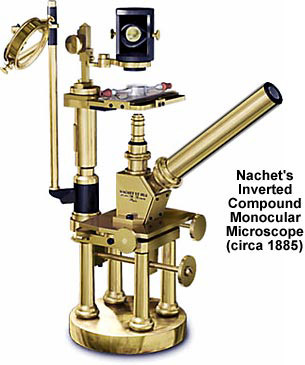Nachet Inverted Compound Monocular Microscope
Camille Sebastien Nachet was a French instrument designer and lens grinder who studied with Vincent Chevalier before opening his own shop in 1840. The inverted microscope designed and build by Nachet is described and illustrated in a short treatise entitled Microscopes to the End of the Nineteenth Century by F. W. Palmer and A. B. Sahiar.

The inscription on this instrument reads "Nachet et Fils, 17, Rue St. SÚverin, Paris, indicating the authenticity of the microscope. A sturdy circular brass base supports four pillars that, in turn, support a platform containing the microscope limb and a prism box with a front silvered mirror. The single eyetube is threaded directly into the prism box, as is the inverted objective. The stage rides on the circular limb and is adjustable via a knurled knob. Coarse focus is achieved by sliding the objective tube, while fine focus is performed by adjusting a screw between the pillars that moves the stage up and down. Above the stage is a housing that contains a condenser lens and a planar mirror that assist in specimen illumination. Also mounted on the limb is an additional bi-convex lens that helps add light to the specimen.
According to Palmer and Sahiar, this inverted chemical microscope was made:
"for the purpose of viewing objects from their underside when heat or reagents are being applied to them. It meets the requirements of observers engaged in the 'cultivation' of the minute organisms which act as ferments".
BACK TO NINETEENTH CENTURY MICROSCOPES
